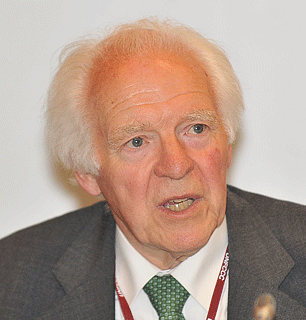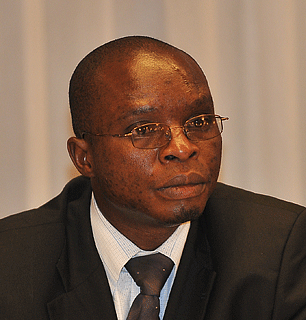 |
A Special Report on Selected Side Events at the 2-13 June 2008 Bonn, Germany |
| Daily Web Coverage and Reports | |||||||||||||||||||||
| Web | 2 June | 3 June | 4 June | 5 June | 6 June | 7 June | 9 June | 10 June | 11 June | 12 June | 13 June | ||||||||||
| HTML | |||||||||||||||||||||
Events on Tuesday, 10 June 2008
Modeling of post-2012 climate policy scenarios: preliminary results
Presented by Pew Center
Elliot Diringer, Pew Center on Global Climate Change (Pew Center), US, highlighted various reports produced by the Pew Center on post-2012 issues. He said the key message from the report entitled, Climate Dialogue at Pocantico, is that all major economies must be engaged in future agreements, and that the best way to achieve this is through a flexible framework in which countries take on different commitment types. He said the aim of modeling post-2012 scenarios is to help visualize options and assess them in terms of environmental effectiveness, economic efficiency, and fairness.
Joanna Lewis, Pew Center, outlined the Center’s development of post-2012 scenarios, detailing the process, data used, and technical constraints. She said the scenarios use policies that reflect what countries are already doing and considers a spectrum of commitment types, including: absolute, intensity and no-lose targets; policy-based commitments; international sectoral agreements; and funds for adaptation and technology. She then described the six scenarios, which use either one or some combination of the commitment types, with some degree of differentiation and graduation criteria within 13 regions.
Leon Clarke, Pacific Northwest National Laboratory, US, explained how the model’s baseline and stabilization pathways were constructed, and stated that all scenarios reflect growth in emissions and GDP in developing counties. He highlighted results from the modeling exercise, focusing on: carbon dioxide concentrations; annual emissions; costs of reducing emissions as a percentage of GDP; regional cost distribution; and funds for carbon capture and storage (CCS) deployment, adaptation, and technology. He stressed that: the same architectures with differing levels of stringency could produce substantially larger reductions; sectoral approaches are not as economically efficient as other options; full trading of emission reductions is the most efficient solution, but favors developed countries; and trading, or policy-based commitments with partial trading, redistributes the costs to benefit developing countries.
Participants discussed: why the model's emission pathways are based on carbon dioxide only; using the concept of common but differentiated responsibilities in modeling sectoral approaches; the model’s assumption that cellulostic biofuels will be used; why the Pew Center used the range 450–600 parts per million stabilization levels; and subsidizing CCS.
 |
| L-R: Joanna Lewis, Pew Center, US; Elliot Diringer, Pew Center, US; and Leon Clarke, Pacific Northwest National Laboratory, US |
|
|
Climate change policies – an economic perspective
Presented by the OECD
Shardul Agrawala, OECD, discussed the economic implications of adaptation, noting that its cost alongside those of mitigation and residual climate damages comprise the climate change “price tag.” He said costing adaptation is important, but that incentivizing it is critical, adding that developing a shared understanding of adaptation and a clear metric to measure progress are precursors to costing it.
Shruti Mehrotra, World Economic Forum, stressed that prior to private sector engagement in adaptation activities, there is a need for: a clear economic, if not business, case for engagement; a clearly defined request from the public sector; a strong interest and willingness to partner from both sides; and robust governance structures and strong project management.
Jan Corfee-Morlot, OECD, introduced two OECD reports: OECD Environmental Outlook to 2030; and Ranking of the World’s Cities Most Exposed to Coastal Flooding Today and in the Future. Noting that the reports contain policy recommendations, she said policy solutions are available, affordable, and achievable.
Jonathan Pershing, World Resources Institute, stressed that the two OECD reports provide significant insight for moving forward. He commented that while the first report successfully isolates environmental indicators, it does not create links between them. On the second report, he stressed that issues of distributional equity are key, and should be included in assessments of exposure risk.
Participants discussed: how the private sector’s role differs between developed and developing countries; the timing of adaptation in the face of uncertainty; what proportion of adaptation costs in developed and developing countries would be publicly versus privately funded; and the importance of focusing on climate change impacts on cities.
 |
| L-R: Jan Corfee-Morlot, OECD; Shardul Agrawala, OECD; and Shruti Mehrotra, World Economic Forum |
|
|
CDM reform: proposals based on lessons learned from IGES CDM capacity building
Presented by IGES
Keisuke Iyadomi, Institute for Global Environmental Strategies (IGES), Japan, explained that IGES builds capacity related to institutional and operational aspects of CDM within Asian countries. He highlighted key activities, including: supporting the operation of Designated National Authorities; assisting carbon credit procurement; and providing useful CDM-related information.
Yuji Mizuno, IGES, in his own capacity, proposed reforms to the CDM, including removing the additionality test for specific project types, such as: wind power; geothermal; photovoltaic; and solar thermal. He said the additionality test imposes significant costs and jeopardizes the predictability of income flows from the CDM. He suggested that because these project types are not profitable without additional incentives, and resulting emissions are low, removing the additionality test could encourage more ambitious reductions than would otherwise be achieved. He also proposed setting a default emission factor for grid-connected electricity, suggesting the average global emission factor.
Yasushi Ninomiya, Ministry of Environment, Japan, presented results from an interim report on a possible emissions trading scheme in Japan. He said the proposed scheme would likely: cover only carbon dioxide emissions initially; not include a price cap but rather an absolute emissions cap on all covered entities; and allocate emission reductions freely at first, with auctions gradually introduced in applicable sectors and industries. He described four possible allocation methods, including upstream allocation to fossil fuel producers, importers and distributors, and downstream allocation to either: large fossil fuel-derived energy users; power companies; or firms, with activity-level emissions treated separately from changes in emissions intensity.
Participants discussed the impact of removing the additionality test for different CDM project types and the political viability of introducing a default emission factor.
 |
| L-R: Keisuke Iyadomi, IGES; Yuji Mizuno, IGES; Taka Hiraishi, IGES; and Yasushi Ninomiya, Ministry of Environment, Japan |
|
|
How could positive incentives work to facilitate a global climate change agreement?
Presented by Foundation for Strategic Environment Research (MISTRA)
Markus Åhman, Swedish Environmental Research Institute, noted that the European Climate Platform facilitates communication between policy makers, researchers, and stakeholders to establish research objectives and develop policy options.
Christopher Egenhofer, Centre for European Policy Studies, said the distinction between Annex I and non-Annex I countries masks differences in mitigation responsibilities, and suggested defining three groups: OECD; non-OECD (mostly emerging economies); and LDCs and comparable countries (including India). He explained that most emissions reductions would come from the first two groups, and argued that the EU and US must take on emissions reduction targets greater than 100% to enable growth in developing countries.
Vivek Kumar, The Education Resources Institute, India, highlighted the need for rapid economic development to provide the basic amenities, services and energy needed to meet the Millennium Development Goals in India. He suggested policies for: domestic actions, focusing on energy efficiency; additional funding and support through bilateral collaboration; and wider international policy support.
Sivan Kartha, Stockholm Environment Institute (SEI), highlighted that any global emissions reduction strategy must ensure sufficient mitigation, support deep and extensive adaptation programmes, and safeguard the right to development.
Astrid Ladefoged, European Commission, identified the need to consider fairness and effectiveness when differentiating between parties, and the importance of balancing measurable, reportable and verifiable (MRV) support with MRV actions.
Mozaharul Alam, Bangladesh Centre for Advanced Studies, said a shared vision of a post-2012 regime is needed in order to determine required levels of technology transfer and finance, and suggested addressing uncertainty regarding the scale of required adaptation funding and who the recipients should be.
Participants discussed inter alia: domestic enabling environments and differences within the G-77 in terms of ability to mitigate.
|
|
Forest monitoring for REDD and sustainable land management for adaptation and mitigation
Presented by FAO
Mette Løyche-Wilkie, Food and Agriculture Organization (FAO), said a global carbon monitoring framework must be: reliable; transparent; cost-effective; capable of producing repeatable results; and adaptable, based on an agreed set of variables, common definitions, and guidance. She noted poor data availability and quality as one challenge to developing a global framework, particularly on past and present deforestation rates and changes over time.
Dan Altrell, FAO, said the FAO can support development of national forest assessments by, inter alia: building capacity; improving knowledge; improving on management systems; and supporting national policy dialogue. He summarized the results of a national-level assessment in the Philippines, noting that national forest monitoring and assessments are the basis for the development of a robust REDD forest-carbon accounting system.
Abel Siampale, Zambia, presented the results of a country-specific Integrated Land-Use Assessment (ILUA). He underscored that Zambia took a cross-sectoral approach to collecting data that included both biophysical and socioeconomic information. He said the way forward for Zambia's ILUA includes: establishing a database on land-use resources, supporting the establishment of long-term monitoring systems across sectors; and disseminating reliable and updated land-use information.
Luc Dubreuil, FAO, and Alejandro Kilpatrick, Global Mechanism, discussed the technical and financial issues associated with supporting REDD in Low Carbon Density Forests (LCDFs). They stressed that many impoverished people live in LCDFs, and that REDD policies should be integrated with those related to agriculture, food security, and poverty reduction. They identified methodological, cost, and livelihood aspects of including LCDFs into REDD planning.
Participants discussed: development-driven and other forms of deforestation; how to promote forest management policies; how to determine appropriate methodologies and best define degradation; indigenous rights; and national reporting.
 |
| L-R: Mette Løyche-Wilkie, FAO; Abel Siampale, Zambia; Dan Altrell, FAO; and Susan Braatz, FAO |
|
|
| Daily Web Coverage and Reports | |||||||||||||||||||||
| Web | 2 June | 3 June | 4 June | 5 June | 6 June | 7 June | 9 June | 10 June | 11 June | 12 June | 13 June | ||||||||||
| HTML | |||||||||||||||||||||
Digimarc and the Digimarc logo are registered trademarks of Digimarc Corporation. The "Digimarc Digital Watermarking" Web Button is a trademark of Digimarc Corporation, used with permission.
Please e-mail the Digital Editor should you have any questions regarding the content of this page.
| Back to IISD RS "Linkages" home | Visit IISDnet | Send e-mail to ENB |
© 2008, IISD. All rights reserved.

















